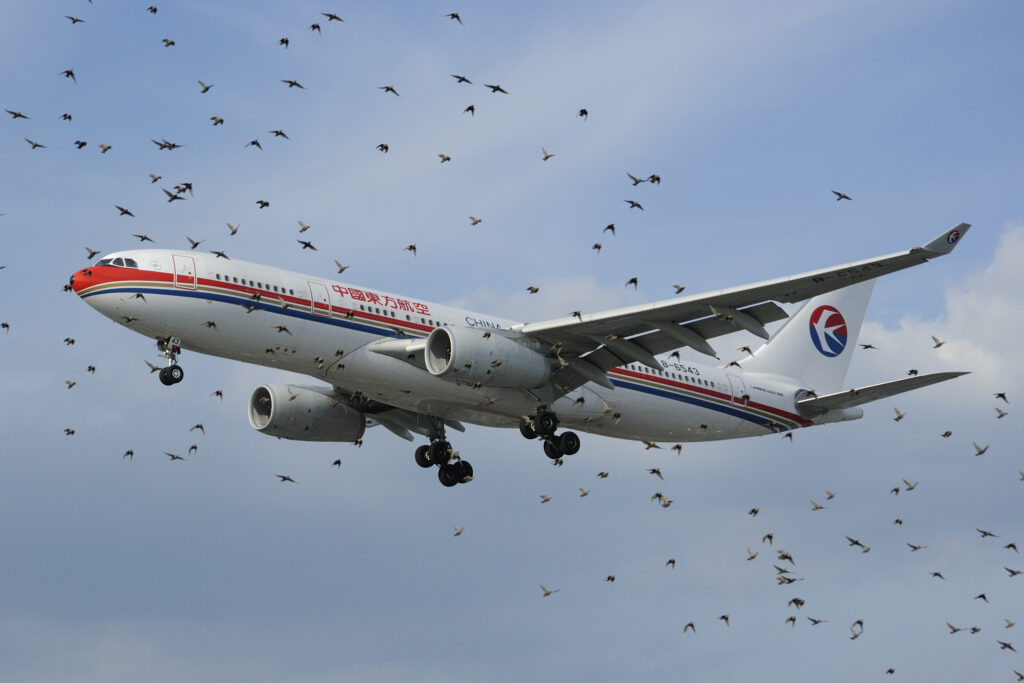Orville Wright hit a bird with the Wright Flyer while flying over an Ohio cornfield in 1905. On October 4, 1960, Eastern Air Lines Flight 375 struck a flock of European starlings during take-off. All four engines were damaged and the aircraft crashed in the Boston harbor with 62 fatalities. Bird collision with aircraft is commonly known as a “bird strike.” Although most bird strikes do not result in crashes, they may cause serious economic damage due to damage to the airframe. Over the years, as planes got faster and lighter, collisions with birds became more of a hazard.
Bird hazards differ among different airports, but most all have wide-open expanses of grass that attract blackbirds, meadowlarks, starlings, pigeons, and geese. Airports located on the coastline or near wetlands attract waterfowl and gulls. During migration, large flocks of birds pose hazards if an airport is in a migratory flyway. The most dangerous time of year is July to October when young birds have left the nest and when migration begins.

There is a Bird Strike Committee, USA, which lists some bird strike facts as: 11,405 wildlife strikes, 97% birds, were reported in 2020, a decrease from the 17, 359 strikes reported in 2019 but it 2021 the number jumped to 15,400. There is an FAA Wildlife Database that you can search for specific incidents. Also, a new unfortunate record: the 600th species of bird was recorded – a Cerulean Warbler. You can read the report here.
- To mitigate the risk of bird strikes, airports and airlines take measures such as:
- Wildlife management programs: Airports and airlines employ wildlife management programs to minimize the presence of birds and other wildlife on and around airport property. These programs use a variety of techniques, such as habitat modification, bird deterrence, and population management.
- Radar and visual monitoring: Airports use radar and visual monitoring systems to detect bird activity near runways and alert pilots to the presence of birds in their flight path.
- Aircraft design: Aircraft manufacturers design aircraft with features that minimize the risk of bird strikes, such as reinforced windshields and engines that are less likely to be damaged by bird strikes.
- Pilot training: Pilots receive training on how to avoid bird strikes and how to respond in the event of a bird strike.
I have a pilot’s license and flew around California for about eight years until I decided that the hobby was too expensive and risky, although I loved it. One early evening I took off from our local private airport. Just as I lifted off, a flock of Yellow-billed Magpies flew in front of me. There was nothing I could do to avoid them but they just passed in front of me. Strangely, straggling behind them was a parrot trying to keep up with the flock. I clipped the parrot with my propeller, or so I thought. I kept wondering during my flight “did I really hit a parrot?” When I landed, I inspected the runway and sure enough, there lay a wounded parrot, probably someone’s escaped pet. It was alive and I brought it to someone I thought could save it, but, I’m sad to say, it expired.
You would think we could do better at avoiding birds with our planes given we have killed so many off with our cats, windows, and habitat destruction.
Do you know if any airports have tried using the ultrasonic sound method I’ve read about for keeping birds away – at least during take-offs and landings?
Ultrasonic sound methods are heavily advertised by companies that make or sell them, but, although birds can hear frequencies down to 20 Hz, they don’t seem to be scared by ultrasound. Other methods are more effective. Yes, some airports use it along with other devices.
Bird strikes are something that worry me, both as a bird watcher and an airline passenger. Lately, I’ve been admiring the sandhill cranes as they head north for the summer in great, noisy, swirling flocks so high that I can hear them, but only quick flashes of silver feathers give their lofty location away. I worry, but I wish them, and the fixed winged “birds”, safe travels and soft landings.
Pingback: Airplane-Bird Strikes – Ornithology - Vetezi